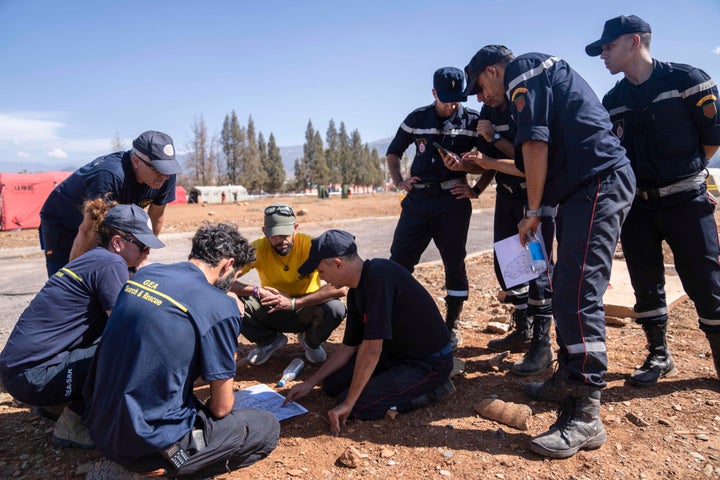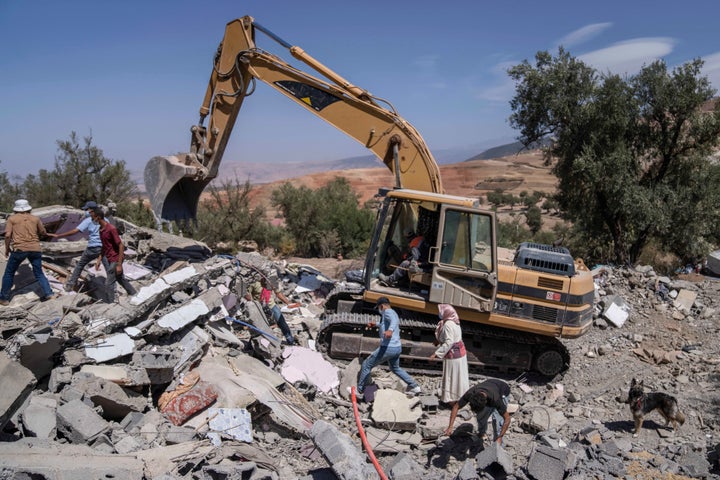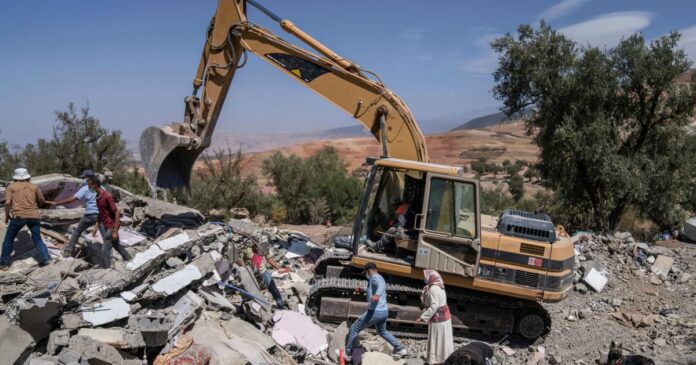TAFEGHAGHTE, Morocco (AP) — His dead relatives have been dug out and buried, but the remnants of Musa Bouissirfane’s former life are still trapped under rubble and dust in the ruins of the mud-brick Moroccan village of Tafeghaghte.
“It’s incredibly challenging to lose your entire family and all your possessions,” Bouissirfane said as tears welled in his eyes in the community less than a two-hour drive from Marrakech. “We have lost everything — our homes, our livestock and all our possessions.”
Less than a week ago, he was excited about his daughter starting second grade. Now he’s mourning her death. Far from ambulances and authorities, villagers could not retrieve her body for more than 14 hours, until Saturday afternoon. The earthquake also killed Bouissirfane’s mother and father and a niece. His wife is hospitalized in an intensive care unit.
The toll of the massive earthquake that killed more than 2,800 people was on stark display Monday in remote villages such as Tafeghaghte, where more than half of the 160 inhabitants are thought to have died, including the four in Bouissirfane’s family.
Mosa’ab Elshamy via Associated Press
Bouissirfane joined with other survivors as they worked to clear debris and recover the dead. They toiled in a scene of horror: Bulldozers dug through dust and rubble hoping to find a body. The air in parts of the village was filled with the stench of dead cattle. People warned each other not to walk near the few buildings that remained standing because they looked like they could topple at any moment.
“God save us,” said Khadija Babamou, a resident of nearby Amizmiz who came to Tafeghaghte to check on relatives. As her eyes panned around the remnants of the village, she covered her mouth and began to cry while gripping her sister.

Mosa’ab Elshamy via Associated Press
Also Monday, Moroccan Prime Minister Aziz Akhannouch met with King Mohammed VI and gave his first public remarks since the earthquake. The prime minister said the North African country was committed to funding rebuilding.
Although Tafeghaghte has received food and water, it needs much more.
“Residents lack the means to purchase even a single brick,” said Bouissirfane, who is living in a tent and has only the change in his pocket.
The efforts in Tafeghaghte mirrored those happening across the disaster zone as Moroccan soldiers, non-governmental organizations and teams sent by Spain, Qatar, Britain and the United Arab Emirates arrived to assist with rescue efforts and immediate needs.
So far, Moroccan officials have accepted government aid from approved non-governmental organizations and just four countries — Spain, Qatar, Britain and the United Arab Emirates. Officials say they want to avoid a lack of coordination that “would be counterproductive.”

Mosa’ab Elshamy via Associated Press
That approach differs from the one taken by the government in Turkey, which made an international appeal for help in the hours following a massive quake earlier this year.
The leader of one of several rescue teams waiting across Europe said Moroccan authorities may remember the chaos that unfolded after a smaller quake in 2004, when international teams overwhelmed the airport and the damaged roads into the hardest hit areas.
Rescuers Without Borders’ founder Arnaud Fraisse told The Associated Press he is withdrawing the organization’s offer to send nine people to Morocco because “our role is not to find bodies.”
Homes crumbled into dust and debris, choking out the air pockets that might allow some people to survive for days under rubble.
“People are generally suffocated by the dust,” Fraisse said.
The United Nations estimates that 300,000 people were affected by the magnitude 6.8 quake, which was made more dangerous by its relatively shallow depth.
Most of the destruction and deaths were in Al Haouz province in the High Atlas Mountains, where steep and winding roads became clogged with rubble leaving villagers to fend for themselves.
Ibrahim Wahdouch lost two young daughters and two other family members. He said Tafeghaghte resembled a war zone.
“There’s not shooting but look around,” he said.
Those left homeless — or fearing more aftershocks — have slept outside in the streets of the ancient city of Marrakech or under makeshift canopies in devastated towns like Moulay Brahim.
State news agency MAP reported that bulldozers and other equipment are being used to clear routes. Tourists and residents lined up to give blood. In some villages, people wept as boys and helmet-clad police carried the dead through streets.

Mosa’ab Elshamy via Associated Press
More help could have quickly poured into Morocco with the government’s permission. Fraisse said about 100 rescue teams — with roughly 3,000 rescuers in total — are registered with the U.N. to help.
“It’s their responsibility. They can do what they want,” Fraisse said, referring to Moroccan authorities. “They didn’t call. So today we think it’s no longer necessary for us to go there, because we won’t do effective work.”
A Spanish search-and-rescue team arrived in Marrakech and headed to the rural town of Talat N’Yaaqoub, according to Spain’s emergency military unit. Britain sent a 60-person search team with four dogs, medical staff, listening devices and concrete-cutting gear.
France, which has many ties to Morocco and at least four of its citizens among the dead, said Moroccan authorities are evaluating proposals on a case-by-case basis.
French Foreign Minister Catherine Colonna said Morocco is “the master of its choices, which must be respected.” She announced 5 million euros ($5.4 million) in emergency funds for Moroccan and international non-governmental groups rushing to help survivors.
French towns and cities have offered more than 2 million euros ($2.1 million) in aid, and popular performers are collecting donations.
The quake had a preliminary magnitude of 6.8, according to the U.S. Geological Survey. A total of 2,681 people were confirmed dead, with nearly 1,600 of them from the hardest-hit Al Haouz province, the Moroccan Interior Ministry reported.
Nearly all the dead have already been buried, the government reported. More than 2,500 people were injured.
Morocco’s deadliest quake was a magnitude 5.8 temblor in 1960 that struck near the city of Agadir, killing at least 12,000. It prompted Morocco to change construction rules, but many buildings, especially rural homes, are not built to withstand such shaking.
Associated Press journalists Mark Carlson in Tafeghaghte, Morocco; Houda Benalla in Rabat, Morocco; John Leicester, Angela Charlton, Elaine Ganley in Paris; Jill Lawless in London; Karel Janicek in Prague; and Jeffrey Collins in Columbia, South Carolina, contributed to this report.


